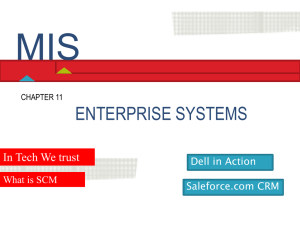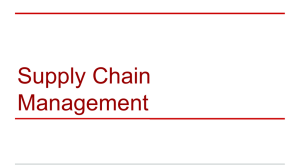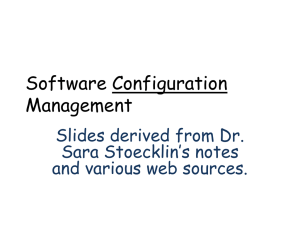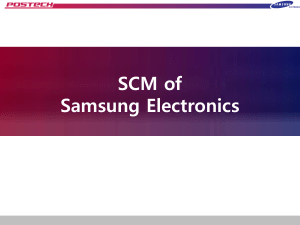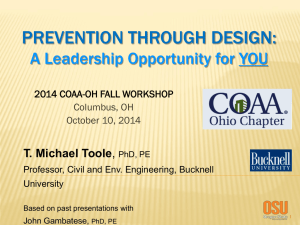HR for SCM advocacy slide presentation
advertisement
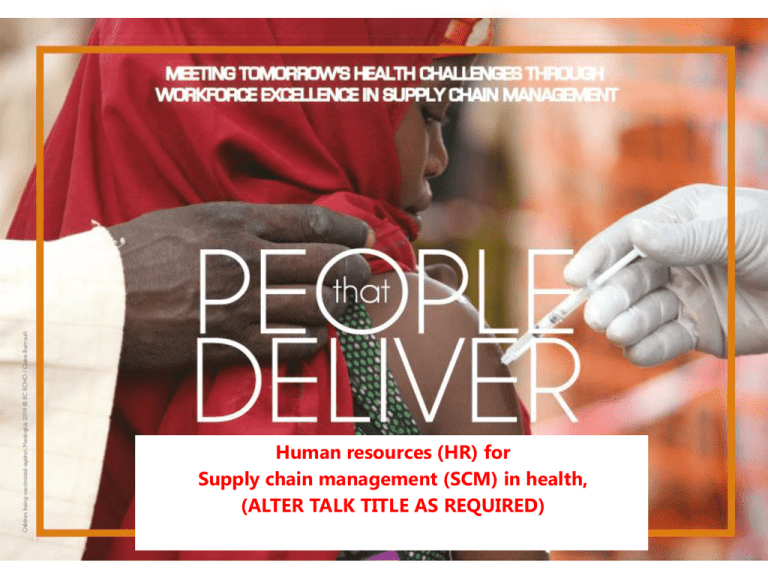
People that Deliver Strategic Plan 2013-2018 Human resources (HR) for Supply chain management (SCM) in health, (ALTER TALK TITLE AS REQUIRED) Welcome INSERT SPEAKER DETAILS HERE Overview 1. The health supply chain workforce WHAT is it? WHY does it matter? 2. The People that Deliver Initiative WHAT is PtD and HOW does it work? 3. The HR building blocks for SCM Explaining a systematic approach? 4. Results from PtD focus countries 5. HOW can you get engaged with PtD? 1. The health supply chain workforce Key messages: HRH is part of health systems strengthening where there is currently a global shortage of healthcare workers. With an increase in global investments in health commodities there is an increased strain on national supply chain systems and staff who run them. Public health supply chains are complex with multiple functions that require, tools, infrastructure, procedures, personnel and management to run them properly. In many countries the personnel who are asked to run the supply chain are under-qualified and not well supported resulting in poor medicine availability. Countries need to change their approach, paying more attention to the human resources that run supply chains, making them more professional. HRH within health system strengthening WHO building blocks Global Shortage of Health Workers Shortage of 4.3 million health workers globally 2.4 million doctors, nurses and midwives 1.9 million management and support staff, including health administrators, managers, and logisticians 57 countries with critical shortages ‘Imagine’ health worker video: http://www.youtube.com/watch?v=tCSmIYmPOi4 Global investments in health commodities Every year billions of US dollars are spent by development partners and national governments procuring health commodities for low- and middle-income countries • Huge increases in the quantity, value and complexity of medicines and commodities flowing through public health supply chains. • Yet more than one-third of the world’s population still lacks regular access to essential medicines (WHO, 2011) Source: WHO, 2012 Strain on national supply chain systems and workers 24-fold increase in the value of new vaccines introduced into a country… … resulted in a 5-fold increase in the workload for supply chain management Source: : WHO/IVB, Apr. 2010 (based on Chad data) Health supply chain functions Source: USAID | DELIVER Project 2010 The complex nature of supply chains – Potter and Brough model http://www.ministerialleadership.org/sites/default/files/capacity%20pyramid%20blog.jpg A change in approach is needed Underqualified & disempowered staff managing public health supply chains Poor availability of health commodities at facilities, wasted resources Supply chains poorly managed and insufficiently resourced Underperforming health programs and unachieved health goals "When you use a nurse or a physician as a logistician, you lose the nurse or physician and you don't get a good logistician!" Prof. Saracino, former Minister of Health, Côte d'Ivoire HR for SCM current paradigm Staff rotation/ migration Limited available resources & incentives SC workforce positions do not require relevant SC qualifications Lack of professional status and performance Shortterm training provided Clinical staff fill SC position Characteristics Short-term focus Significant expenditure Requires extensive external assistance Limited long-term progress in human capacity Limited sustainability or institutionalization HR for SCM desired paradigm National institutions provide relevant qualifications SCM jobs desirable; qualifications sought Characteristics Long term focus Requires reform of perceptions, policies and practices Appropriate Converts existing career expenditures into incentives provided investment Capacity benefits accumulate over time Inherently sustainable and country-driven Qualified staff hired/ contracted for SCM positions Elevated status for SCM and SCM workforce High staff satisfaction and retention Questions 2. The People that Deliver Initiative Key messages: The People that Deliver (PtD) Initiative was founded in 2011 to focus on promoting sustainable workforce excellence in health supply chain management. PtD has a clear vision, mission and strategy to meet its goals with the aid of PtD members. A focused working group structure lead by an Executive Manager and directed by a Board, provides the basis for activity in PtD focus countries and broader global engagement Improving health outcomes by promoting sustainable workforce excellence in health supply chain management 70+ member organizations country governments international agencies academic institutions implementing partners Non-governmental organizations private companies Significant PtD Milestones June 2011, PtD Global Harmonization and Positioning Conference, WHO Geneva July 2011 – Dec 12, PtD Board established with TOR, admin, focus countries, & working groups established. (Advocacy & Knowledge Management, Technical, & Research) June 2012, UNICEF offers to host the PtD Secretariat June 2013, Appointment of Executive Manager for PtD June 2013, Approval of PtD Strategic Plan Aug 2013, PtD Operational Plan approved Vision The People that Deliver Initiative envisions a world where national supply chain workforces are planned, financed, developed and supported in a way that ensures equitable and sustainable access to the medicines and other commodities needed for optimal health outcomes. Mission People that Deliver is a global partnership whose mission is to build global and national capacity to implement evidencebased approaches to plan, finance, develop, support and retain the national workforces needed for the effective, efficient and sustainable management of health supply chains. Strategic goals I. Global recognition that strong supply chains are essential for positive health outcomes and require a competent, recognized and supported supply chain workforce with significant technical and managerial capacity. II. Government and national health institutions demand, recruit and retain appropriately qualified personnel for positions with supply chain responsibilities. Strategic goals III. Adequate personnel from relevant cadres with appropriate supply chain competencies and qualifications are available. IV. A repository of evidence-based resources for HR for SCM is established, accessible, used and disseminated. Principles Country lead activity Globally influenced but locally applied Systematic approach to HR for SCM Professionalization of SCM workforce (logisticians or health based, local context) Inclusive of private sector All levels of the supply chain Selection, quantification, procurement, storage, distribution, use Consider the “know do” gap Structure of PtD Members Board Secretariat AKMWG TWG Focus countries RWG Current Board country governments international agencies academic institutions implementing partners nongovernmental organizations private companies Expected main customers PtD core services PtD Operational Plan Provision of advocacy materials, and strategies in response to requests on issues relating to HR for SCM PtD Members How to access PtD services Direct engagement with the secretariat info@peoplethatdeliver.org Development and/or application of Direct engagement with country specific best practice working group leads See www.peoplethatdeliver.org approaches, tools and evidence for Country governments specific HR for SCM country based Use of procurement and Supply interventions Management (PSM) Tool box International http://www.psmtoolbox.org/en/ organizations & Facilitation of linkages where an initiatives identified need exists (e.g. Laptop SCM education technical expertise, resource repository mobilisation, etc.) Regional networks and organizations Encourage exchange of country – experiences (south-to-south www.rhsupplies.org/resourcestools/laptop.html Questions 3. The HR Building Blocks for SCM Key messages: A systematic approach to HR for SCM requires attention to be given to five different HR building blocks in any given context. A HR for SCM assessment tool has been published by the USAID/DELIVER Project in conjunction with PtD and is available for use. The results of any assessment need to inform the development of a strategic and operational plan with engagement from SCM stakeholders as a basis for sustainable change. A Systematic Approach to HR for SCM Block 1 Block 2 Block 3 Block 4 Block 5 Engaged Stakeholders Optimise Policies & Plans Workforce Development Increase Performance Professionalisation of SCM Block 1Engaged Stakeholders Stakeholders, who provide technical leadership and advocacy in the field of supply chain management (SCM), as well as human resource management. Block 2 – Optimise Policies and Plans Policies, plans, and associated standard operating procedures (SOPs) that support human resource capacity development and management, including finance and human resource information systems (HRIS). Block 3 – Workforce Development Initiatives that focus on identifying and building a robust workforce, including recruiting, competency modelling and development, and pre-service education and continued professional development. Block 4 – Increase Performance Management initiatives that identify and enhance workforce performance, including retention, supervision, mentoring and coaching, and task shifting. Block 5 – Professionalisation of SCM Processes designed to establish supply chain roles or a set of professional responsibilities/competencies. Including minimum pre-service education, professional networks and registration. How to Assess HR for SCM USAID DELIVER Project with PtD Human Resource Capacity Development in Public Health Supply Chain Management: Assessment Guide and Tool Dashboard of the five building blocks How to Assess HR for SCM Step 1: Conduct Assessment Step 2: Develop Strategic Plan Step 3: Develop Operational Plan Questions 4. Results from PtD focus countries Dominican Republic Burkina Faso Ethiopia Liberia Indonesia Mozambique Namibia Key messages: Activity is most sustainable when HR for SCM assessments are used to develop strategic and operational plans. A more sustainable approach occurs when key SCM stakeholders work together to implement activities. Mozambique Following a HR for SCM assessment in 2011, the MOH recently approved a new pharmaceutical logistics strategic plan which foresees significant reform of the HR structures and systems for public health supply chain managers. The plan has three main components: Build up a logistics cadre in Mozambique with private sector partnerships Working with ministry on HR for SCM cadres aiming to free up clinical cadres for more clinical work. Retention strategies will also be considered. Within the Central Medical Stores they are investigating how to incentivise, motivate and coach staff. PtD members involved in this project include: JSI, Village Reach, Deloite, Accenture Namibia Following a HR for SCM assessment the following areas of specific focus have been identified: To provide technical assistance to the Namibian MOHSS for enhanced planning, deployment, training and retention of the SCM workforce. To document the implementation process, identify lessons learned, and draft a case study/guidance document on strengthening the SCM workforce that can be shared for additional testing and replication in other countries. Specific projects include SCM competency mapping, workload analysis and SCM education. PtD members involved in this project include: Capacity Plus, SCMS, SIAPS, Dominican Republic & LAC Following an initial HR for SCM management assessment in the Dominican Republic plans are moving forward to: Developed job descriptions and a supervision manual for supply chain staff Develop a diploma course that is being institutionalized through the National Institute of Public Administration and in collaboration with a local university Engaged with other LAC partners in a regional workshop on HR for SCM More broadly in the LAC region: El Salvador has, and Guatemala is due to, undertake HR for SCM assessment El Salvador has requested the development and delivery of a workshop to strengthen the motivation and supportive supervision of supply chain workers. PtD members involved in this project include: CapacityPlus, SIAPS, Questions 5. How can you get engaged with PtD? Become a PtD member (go to www.peoplethatdeliver.org) Join a PtD working group (e-mail info@peoplethatdeliver.org) Become a PtD Twitter follower (@PplthatDeliver) Update LAPTOP with SCM courses offered by your own institution (visit http://www.rhsupplies.org/resources-tools/laptop) Tell us your HR for SCM stories or projects Advocate for HR for SCM within your organization For more information, contact the Secretariat: info@peoplethatdeliver.org the Executive Manager: executivemanagerptd@unicef.org A brief summary 1. The health supply chain workforce What is it? Why does it matter? 2. The People that Deliver Initiative What is PtD and how does it work? 3. The HR building blocks for SCM Explaining a systematic approach? 4. Results from PtD focus countries 5. How can you get engaged with PtD? Questions




